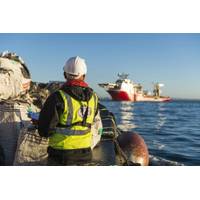Glencore's Profit Falls, Debt Target Lowered
Coal hedging loss disappoints investors, share price falls 5 percent.
Glencore said it expected to exceed a previous target to cut debt but it took a nearly $400 million hit from a bad bet on coal and echoed warnings voiced by mining rivals of volatile commodity markets.
Along with Anglo American, Glencore (GLCNF) was among the companies worst affected by a commodity price rout and has been among the biggest gainers from a rebound this year.
After more than doubling since the end of 2015, its share price fell nearly 6 percent by 0948 GMT as analysts focused on news of a $395 million cost on coal hedging.
They also said they were disappointed a target for full-year earnings guidance of $2.4-$2.7 billion for its commodity trading business had not been raised.
Chief Executive Ivan Glasenberg said the firm was "mindful that underlying markets continue to be volatile". But the firm was more than on track to cut debt to strengthen its balance sheet against any future shocks.
"We have already largely achieved our asset disposals target of $4-5 billion with a diverse and material pool of asset sales' processes also ongoing," Glasenberg said.
Ahead of the results, Glencore agreed to sell a stake in its Ernest Henry copper mine in Australia to Evolution Mining for A$880 million ($670 million).
The company expects to cut debt to between $16.5 billion and $17.5 billion this year, better than a previous goal to lower debt to $17 billion to $18 billion by the end of 2016.
SNAGGED ON THE HEDGE
Glencore stands apart from the other major miners because of a trading portfolio that can protect it when commodity prices fall, but not all of its hedges have succeeded.
The firm, which is heavily exposed to coal, reported a $395 million loss on a coal hedging operation when coal prices unexpectedly rose following Chinese action to address overcapacity.
Glasenberg told analysts the adjustment was not "a big deal", but analysts questioned whether a company such as Glencore should be hedging coal at all.
"Hedging is a justifiable tool for small marginal operators that need to cover their cost bases. We would not expect the world's largest seaborne thermal coal producer to be hedging its product," Hunter Hillcoat, analyst at Investec (ITCFY) said.
Glencore maintained full-year EBIT (Earnings before interest and tax) guidance of $2.4-$2.7 billion for the trading operations, following a first-half figure of $1.2 billion.
For the company overall, Glencore reported first-half adjusted EBITDA of $4 billion compared with a consensus of $3.9 billion and 13 percent lower than a year ago.
Analysts say EBITDA, earnings before interest, tax, depreciation and amortisation, is a crucial measure of how well capital-intensive miners are doing at generating returns on their core operations.
After tax, it announced a first-half net loss of $369 million, down from a loss of $676 million the same time last year.
By Barbara Lewis and Dmitry Zhdannikov








